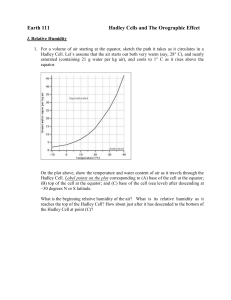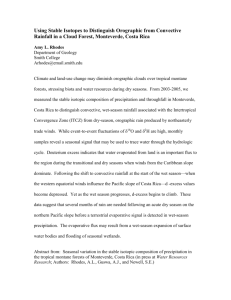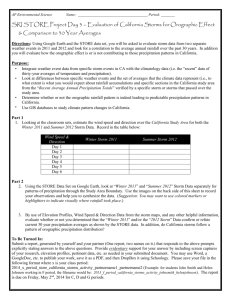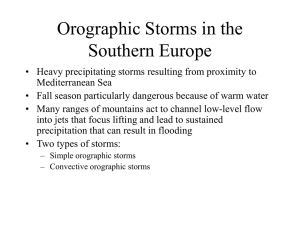Lin, Y.-L., 2005
advertisement
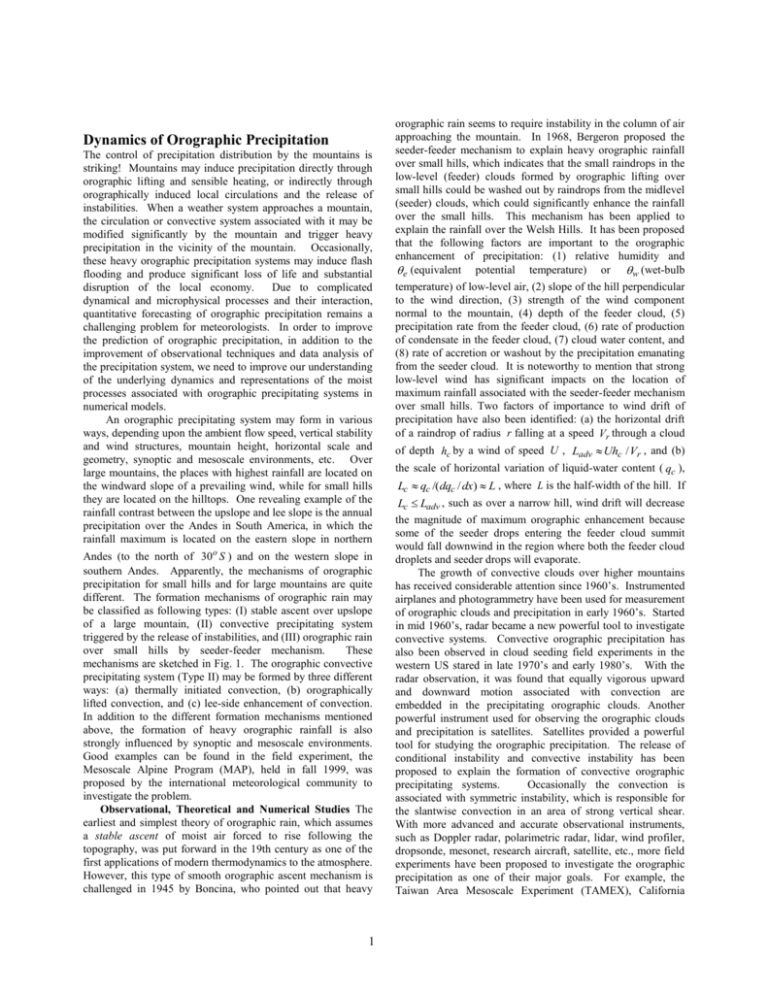
Dynamics of Orographic Precipitation The control of precipitation distribution by the mountains is striking! Mountains may induce precipitation directly through orographic lifting and sensible heating, or indirectly through orographically induced local circulations and the release of instabilities. When a weather system approaches a mountain, the circulation or convective system associated with it may be modified significantly by the mountain and trigger heavy precipitation in the vicinity of the mountain. Occasionally, these heavy orographic precipitation systems may induce flash flooding and produce significant loss of life and substantial disruption of the local economy. Due to complicated dynamical and microphysical processes and their interaction, quantitative forecasting of orographic precipitation remains a challenging problem for meteorologists. In order to improve the prediction of orographic precipitation, in addition to the improvement of observational techniques and data analysis of the precipitation system, we need to improve our understanding of the underlying dynamics and representations of the moist processes associated with orographic precipitating systems in numerical models. An orographic precipitating system may form in various ways, depending upon the ambient flow speed, vertical stability and wind structures, mountain height, horizontal scale and geometry, synoptic and mesoscale environments, etc. Over large mountains, the places with highest rainfall are located on the windward slope of a prevailing wind, while for small hills they are located on the hilltops. One revealing example of the rainfall contrast between the upslope and lee slope is the annual precipitation over the Andes in South America, in which the rainfall maximum is located on the eastern slope in northern Andes (to the north of 30o S ) and on the western slope in southern Andes. Apparently, the mechanisms of orographic precipitation for small hills and for large mountains are quite different. The formation mechanisms of orographic rain may be classified as following types: (I) stable ascent over upslope of a large mountain, (II) convective precipitating system triggered by the release of instabilities, and (III) orographic rain over small hills by seeder-feeder mechanism. These mechanisms are sketched in Fig. 1. The orographic convective precipitating system (Type II) may be formed by three different ways: (a) thermally initiated convection, (b) orographically lifted convection, and (c) lee-side enhancement of convection. In addition to the different formation mechanisms mentioned above, the formation of heavy orographic rainfall is also strongly influenced by synoptic and mesoscale environments. Good examples can be found in the field experiment, the Mesoscale Alpine Program (MAP), held in fall 1999, was proposed by the international meteorological community to investigate the problem. Observational, Theoretical and Numerical Studies The earliest and simplest theory of orographic rain, which assumes a stable ascent of moist air forced to rise following the topography, was put forward in the 19th century as one of the first applications of modern thermodynamics to the atmosphere. However, this type of smooth orographic ascent mechanism is challenged in 1945 by Boncina, who pointed out that heavy 1 orographic rain seems to require instability in the column of air approaching the mountain. In 1968, Bergeron proposed the seeder-feeder mechanism to explain heavy orographic rainfall over small hills, which indicates that the small raindrops in the low-level (feeder) clouds formed by orographic lifting over small hills could be washed out by raindrops from the midlevel (seeder) clouds, which could significantly enhance the rainfall over the small hills. This mechanism has been applied to explain the rainfall over the Welsh Hills. It has been proposed that the following factors are important to the orographic enhancement of precipitation: (1) relative humidity and e (equivalent potential temperature) or w (wet-bulb temperature) of low-level air, (2) slope of the hill perpendicular to the wind direction, (3) strength of the wind component normal to the mountain, (4) depth of the feeder cloud, (5) precipitation rate from the feeder cloud, (6) rate of production of condensate in the feeder cloud, (7) cloud water content, and (8) rate of accretion or washout by the precipitation emanating from the seeder cloud. It is noteworthy to mention that strong low-level wind has significant impacts on the location of maximum rainfall associated with the seeder-feeder mechanism over small hills. Two factors of importance to wind drift of precipitation have also been identified: (a) the horizontal drift of a raindrop of radius r falling at a speed Vr through a cloud of depth hc by a wind of speed U , Ladv Uhc / Vr , and (b) the scale of horizontal variation of liquid-water content ( qc ), Lc qc /( dqc / dx) L , where L is the half-width of the hill. If Lc Ladv , such as over a narrow hill, wind drift will decrease the magnitude of maximum orographic enhancement because some of the seeder drops entering the feeder cloud summit would fall downwind in the region where both the feeder cloud droplets and seeder drops will evaporate. The growth of convective clouds over higher mountains has received considerable attention since 1960’s. Instrumented airplanes and photogrammetry have been used for measurement of orographic clouds and precipitation in early 1960’s. Started in mid 1960’s, radar became a new powerful tool to investigate convective systems. Convective orographic precipitation has also been observed in cloud seeding field experiments in the western US stared in late 1970’s and early 1980’s. With the radar observation, it was found that equally vigorous upward and downward motion associated with convection are embedded in the precipitating orographic clouds. Another powerful instrument used for observing the orographic clouds and precipitation is satellites. Satellites provided a powerful tool for studying the orographic precipitation. The release of conditional instability and convective instability has been proposed to explain the formation of convective orographic precipitating systems. Occasionally the convection is associated with symmetric instability, which is responsible for the slantwise convection in an area of strong vertical shear. With more advanced and accurate observational instruments, such as Doppler radar, polarimetric radar, lidar, wind profiler, dropsonde, mesonet, research aircraft, satellite, etc., more field experiments have been proposed to investigate the orographic precipitation as one of their major goals. For example, the Taiwan Area Mesoscale Experiment (TAMEX), California Lanfalling Jets Experiment (CALJET), Mesoscale Alpine Programme (MAP), Improvement of Microphysical PaRameterization through Observational Verification Experiment (IMPROVE-II) have been conducted in 1987, 1997/98, 1999, and 2001, respectively. These measurements, along with more advanced analysis techniques, have helped our understanding of orographic precipitation, especially orographic convective systems, in the last two decades. A number of authors have built up theoretical models to study the problem of moist airflow over mountains and apply their results to explain the formation and propagation of the orographic precipitating systems. The most straightforward approach to treat the moisture effects is to assume that the latent heating is everywhere proportional to the vertical velocity, i.e. q w , where q is the latent heating rate and is a constant. This particular parameterization of q in terms of w requires that the heat added to an air parcel lag the vertical displacement by a quarter cycle. It follows that the buoyancy forces can do no work and therefore that the heat can only modify, but not generate, internal gravity waves. Based on theoretical approach, it has been found that: (a) mountain waves are strengthened (weakened) by low-level sensible cooling (heating) in a study of airflow over a two-dimensional mountain ridge when the basic wind is strong; (b) a convergence of the vertical momentum flux at the heating level, which tends to accelerate the flow there. This phenomenon appears to be related to wave-CISK (Conditional Instability of the Second Kind) mechanism; (c) prescribed heating (cooling) tends to produce downward (upward) displacement, thus reduces (enhances) the drag on the mountain; and (d) special treatment is required to avoid net heating problem. Some important dynamical processes have been obtained by the above-mentioned theoretical studies, which have shed lights to improve the parameterization or representation of physical processes in numerical models. However, almost all of the theories have some constraints, such as small-amplitude assumption, relatively simpler representations of moist processes, idealized environments, etc. In order to have a more realistic representation of the complicated orographic rain processes for improving the quantitative precipitation forecasting, numerical modeling appears to be the natural choice. Compared to some approximations made in theoretical studies, such as small-amplitude (linear), two-dimentionality, idealized basic states, and simple representation of microphysical processes, and the coarse data used for observational analysis, numerical modeling study provides an alternative, powerful tool in studying the dynamics of orographic precipitating processes. Numerical simulations of orographic precipitation have come a long way to reach today's status, although the quantitative forecast of orographic precipitation remains challenging. The major advancements in numerical modeling of orographic precipitation in the 1970's and 1980's have also benefited from the improvements in supercomputing power and numerical techniques, such as the open lateral boundary condition, radiation and absorbing-layer upper boundary conditions, terrain-following coordinates, stretching and staggering grid structures, cumulus and microphysical parameterization schemes, boundary layer parameterizations, more accurate numerical integration techniques, merging of cloud and mesoscale models, etc. 2 These improvements make it possible to do some detailed case simulations of orographic precipitation. In the 1990's, the major advancement are the improvements on initialization schemes, data assimilation schemes, more mesonets, more field experiments targeted at orographic rain problem which provide better data for modeling, availability of numerical models in the public domain, and more powerful computers, improvements in global models and numerical weather prediction models (which provide initial data for mesoscale models), among other things, which make more accurate real-case simulations and real-time mesoscale prediction possible. Even though some significant advancement in numerical modeling has been made in the last several decades, quantitative precipitation forecasting of orographic rain remains challenging. In particular, numerical modeling results are still sensitive to cumulus and microphysical parameterization schemes. With the same set of parameterization schemes installed in the same model, noticeable differences in the results could be different for different weather systems. For example, the Kain-Fritsch cumulus parameterization scheme is found to be more suitable for simulating stronger weather systems. On the other hand, the Grell cumulus parameterization scheme does a better job in simulating weaker weather systems. In the meantime, the Betts-Miller scheme is found to be more suitable for grid resolution coarser than 30 km . Some inconsistent results have also been generated by adopting different microphysical parameterization schemes in simulating the same orographic precipitation event, and by adopting the same microphysical parameterization scheme in simulating two different orographic precipitation events. Effects of Synoptic and Mesoscale Environments Severe orographic precipitation events are often associated with weather systems, such as troughs, fronts, storms, tropical cyclones, etc. Some common synoptic and mesoscale environments shared by heavy orographic precipitation have been recognized as early as the 1940's. Based on the analysis of several severe orographic precipitation events occurred in the US, Alps, Taiwan, and Japan, the following synoptic and mesoscale features have been observed: the following common features are observed: (1) a conditionally or potentially unstable airstream impinging on the mountains, (2) the presence of a very moist and moderate to intense LLJ (lowlevel jet), (3) the presence of steep orography to help release the conditional or convective instability, and (4) the presence of a quasi-stationary synoptic scale system is required to impede or slow the progress of the orographically-forced convective system over the threat area. For example, a sketch of synoptic and mesoscale environments conducive to heavy orographic precipitation, which could lead to flooding, on the southern side of the Alps can be found in Fig. 2. When a midlatitude cyclone or a frontal system approaches a mesoscale mountain, conditional and/or convective instability may be triggered due to orographic lifting of the lower-layer of the incoming air. The warm conveyor belt undergoing forward-sloping ascent ahead of a front is often considered to be responsible for providing the LLJ and moisture for generating heavy orographic rainfall. In addition, a differential advection mechanism has been proposed to explain the orographic precipitation associated with deep convection and extending far upstream during the passage of fronts. Moist Flow Regimes and Common Ingredients Based on idealized simulations for a moist flow over a mountain, the flow regimes may be categorized based on the unsaturated moist Froude number, defined as Fw U / Nwh , where N w is the moist Brunt-Vaisala frequency, to classify the characteristic of the propagation of the orographically induced mesoscale convective system. For a conditionally unstable airflow over a mesoscale mountain, three moist flow regimes may be identified: (I) upstream propagating convective system, (II) stationary convective system, and (III) both stationary and downstream propagating systems (Fig. 3). For a threedimensional flow, it is found that heavy upslope rainfall might be produced in the presence of a LLJ under regimes II and III, more in line with observations. Note that, in addition to the presence of a LLJ, it appears that some other synoptic and mesoscale features may also play important roles in controlling the generation of heavy orographic rain. In addition to the moist Froude number, flow regimes are also controlled by other parameters, such as CAPE (convective available potential energy), steepeness of the orography, vertical wind shear, etc. The total precipitation ( P ) may be estimated by P E( / w )( wq)( Ls / cs ) , where E is the precipitation B. Smith et al., Local and remote effects of mountains on weather: Research needs and opportunities. Bull. Amer. Met. Soc., 78, 877-892, 1997; R. B. Smith, The influence of mountains on the atmosphere. Adv. in Geophys., 21, Aca. Press, NY, 87-230, 1979; C.-M. Chu and Y.-L. Lin, Effects of orography on the generation and propagation of mesoscale convective systems in a two-dimensional conditionally unstable flow. J. Atmos. Sci., 57, 3817-3837, 2000; P. Binder and C. Sch ar , MAP design proposal. MeteoSwiss, 75 pp., 1996; P. Bougeault et al., The MAP special observing period. Bull. Amer. Met. Soc., 82, 433-462, 2001; T. Bergeron, Studies of the oreigenic effect on the areal fine structure of rainfall distribution. Met. Inst. Uppsala U., Rep. No. 6, 1968; K. A. Browning, Structure and mechanism of precipitation and the effect of orography in a wintertime warm sector. Q. J. Roy. Met. Soc., 100, 309-330, 1974; R. R. Braham and M. Dragnis, Roots of orographic cumuli. J. Meteor., 16, 214-226, 1960; R. B. Smith and Y. -L. Lin, The addition of heat to a stratified airstream with application to the dynamics of orographic rain. Quart. J. Roy. Meteor. Soc., 108, 353-378, 1982; Y.-L. Lin et al., Some common ingredients for heavy orographic rainfall. Wea. Forec., 16, 633-660, 2001. efficiency, w is the liquid water density, and q are the lower moist layer average air density and the water vapor mixing ratio, Ls and cs are the horizontal scale and propagating speed of the precipitating system. For flow over a mountain range, the low-level upward vertical motion may be controlled by either orography or the environment (e.g. uppertropospheric divergence induced upward motion), w woro wenv . The orographically-forced upward motion may be roughly estimated by the lower boundary condition for flow over orography, woro VH h , where h is the mountain height function and V H is the low-level horizontal wind velocity. The total precipitation can then be estimated by P E( / w ) VH h wenv q (Ls / cs ). Based on the above equation, heavy orographic rainfall requires significant contributions from any combination of the following common ingredients: (1) high precipitation efficiency of the incoming airstream (large E), (2) an intense low-level jet (large VH ), (3) steep orography (large h ), (4) favorable (i.e. concave) mountain geometry and a confluent flow field, (large VH h ), (5) strong synoptically forced upward vertical motion (large wenv), (6) a high moisture flow upstream (large q), (7) the presence of a large, pre-existing convective system (large L)s, (8) slow (impeded) movement of the convective system (small c s ), and (9) a conditionally or convectively (potentially) unstable low-level flow. Fig. 1. Formation mechanisms of orographic precipitation: (a) Stable ascent over large mountains, (b) convective precipitating system, and (c) orographic rain over small hills by seederfeeder mechanism. (Adapted after Chu and Lin 2000) For background information see ATMOSPHERE; ……. in the McGraw-Hill Encyclopedia of Science & Techonology. Yuh-Lang Lin Bibliography. R. M. Banta, The role of mountain flows in making clouds. In Atmos. Process. over Complex Terrain, Meteor. Monogr., 45, Amer. Meteor. Soc., 229-283, 1990; R. 3 Fig. 2. A schematic for the synoptic and mesoscale environments conducive to Alpine orographic rain. Fig. 3. Moist flow regimes for a conditionally unstable flow over mountains: (a) regime I: upstream propagating convective system, (b) Regime II: stationary convective system, and (c) Regime III: both stationary and downstream propagating systems. (Adapted after Chu and Lin 2000) Key words: Orographic precipitation, orographic rain, orographic cloud, seeder-feeder mechanism, low-level jet, convective system, moist flow regimes, conditionally unstable flow, convectively unstable flow, CAPE. Useful websites: (1) http://www.map.ethz.ch/; http://improve.atmos.washington.edu/; http://mesolab.meas.ncsu.edu. (2) (3) Author’s E-mail Address: yl_lin@ncsu.edu. 4
